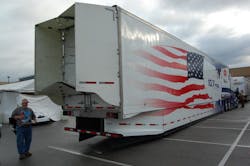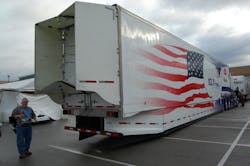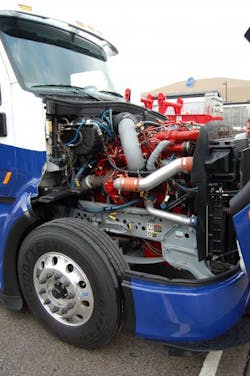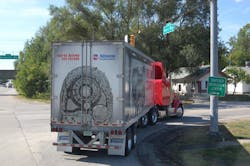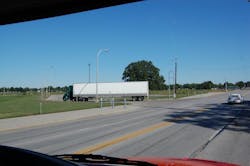Transferring SuperTruck savings to the real world
So I got a chance to chat electronically recently with Mario Sanchez – director of technical sales enablement for engine-maker Cummins – and Ken Damon – manager of vehicle performance for Peterbilt Motors Co. – about some of the findings from a joint test vehicle they are operating under the auspices of the Department of Energy’s (DOE’s) SuperTruck program begun several years ago.
Several truck OEMs are involved in the SuperTruck program – you can read about Daimler Trucks North America’s test vehicle here and here, and some of Navistar’s early project work with ATDynamics (recently acquired by Stemco) for the DOE here – and all of them are achieving some impressive fuel economy numbers.The trick, of course, will be re-creating those test vehicle accomplishments in the real world with production-line equipment.
“The SuperTruck [program] is a great example of several things working together – optimizing components and systems, enhancing aerodynamic efficiencies, and maximizing operator performance,” Peterbilt’s Damon explained to me.
[To view more photos of Peterbilt’s iteration of the SuperTruck, click here.]
“During testing, we did run [our] SuperTruck at 80,000 lbs. and achieved an average of 10.4 miles per gallon (MPG),” he noted. “While the driver will always be essential to vehicle operation and fuel efficiency, automation does help immensely. Using technologies such as predictive cruise control has a significant impact on fuel economy as the vehicle optimizes acceleration, coasting and braking based on terrain, such as road inclines, far ahead of what the driver can anticipate.”
Cummins’ Sanchez added that recovering energy loss due to friction and heat rejection remain some of the key challenges for engines that operate in diverse duty-cycles and environments – and thus also remains the key to unlocking further improvements in fuel economy.“We are continually working on delivering engine systems that leverage all of our subsystems developed and designed in house from our VGT [variable geometry turbocharger] to the aftertreatment system,” he said.
“Additionally, products such as the SmartAdvantage powertrain Cummins and Eaton have developed help reduce driver variability and increase fuel economy by utilizing advanced engine features like vehicle acceleration management,” Sanchez said.
He pointed out that the Cummins/Peterbilt SuperTruck program combined a more efficient diesel engine, an advanced waste heat recovery system, an aerodynamic Peterbilt tractor and trailer combination, and a lithium ion battery-based auxiliary power unit to reduce overnight engine idling that in some cases helped the vehicle attain 10.7 MPG.
Yet attaining and sustaining such numbers in real-world work environments remains a major difficulty, Sanchez emphasized.
“MPG will always be duty cycle dependent and the transient nature of these duty cycles makes it difficult to state if certain fuel economy values will be able to be reached and maintained in specific environments,” he noted.
Near term, Peterbilt’s Damon emphasized that the focus will be on convincing fleets to alter their truck and trailer specs to gain a more fuel efficient footprint.
“Sometimes, out of habit or misconception, customers will still want to spec the largest engine with the most horsepower. That results in more weight and more fuel cost,” he explained. “After they realize they can get the job done just as well with a smaller-block engine, they never look back.”Damon believes automated mechanical transmissions (AMTs) and their fully automatic brethren – gearboxes like Allison’s TC10 model – will only continue to steadily gain popularity.
“They save fuel and can improve operator performance,” he stressed. “Particularly with the driver shortage, anything we can do to make novice drivers perform better helps lower fuel costs [while] resulting in greater operator satisfaction.”
Damon added that, like most truck OEMs, Peterbilt is continuing to develop “optimized spec packages” to not only deliver vehicles finely-tuned for fuel efficiency to the best their application will allow but to simplify the ordering process for customers as well.
“Last year we introduced APEX, an optimized powertrain that pairs the PACCAR MX-13 engine with [Eaton’s] Fuller Advantage AMT,” he noted. “That combination features optimized shift calibration, weight savings and proprietary control logic that result in up to a 4% improvement in fuel efficiency.”
Another new Peterbilt package in the same vein is the Model 579 EPIQ that can improve fuel efficiency by up to 14%, Damon said – a package that combines APEX with a full range of aerodynamic add-ons and closeouts, low rolling resistance tires and other fuel-saving technologies.
A little farther down the road, he believes the “design envelope” of the tractor-trailer will need to expand so it can adapt on the fly to changing conditions seen over the road.“This means developing active aerodynamic devices that deploy at certain speeds and/or that react to changing wind conditions in order to keep the vehicle in the optimal aerodynamic configuration at all times,” Damon pointed out.
Cummins’ Sanchez added that engine “down-speeding,” which relates to lowering engine cruise RPMs, remains a big opportunity to further fuel economy gains.
Additionally, the ability to recover and store more energy via waste heat recovery systems that were tested in the in SuperTruck are now being evaluated for real-world deployment.
“Adoption of waste heat recovery technology – the process of utilizing the excess heat generated from the engine as useful energy – will be a function of customer expectations, duty-cycle requirements and payback,” he explained. “Yet it is a technology that has potential to be key in delivering fuel efficiency gains in the future. It's a technology that Cummins expects to deploy in the future.”
Peterbilt’s Damon also noted that “platooning” is being closely looked at as an “operational way” to further cut fuel consumption.
“This does not remove the driver from being an integral part of vehicle operation, but it does allow two or more tractor-trailers to intelligently work together to maximize fuel economy,” he stressed.
“Braking and acceleration are synchronized between the vehicles which saves fuel, stop-and-go traffic is less frustrating for the operator and both vehicles benefit aerodynamically from the synchronized setup,” Damon said.
Just goes to show that even though the need to move freight from point A to point B may seem simple on the outside, the engineering know-how being deployed to make such movements ever more efficient is complex and shows no signs of slowing down.
